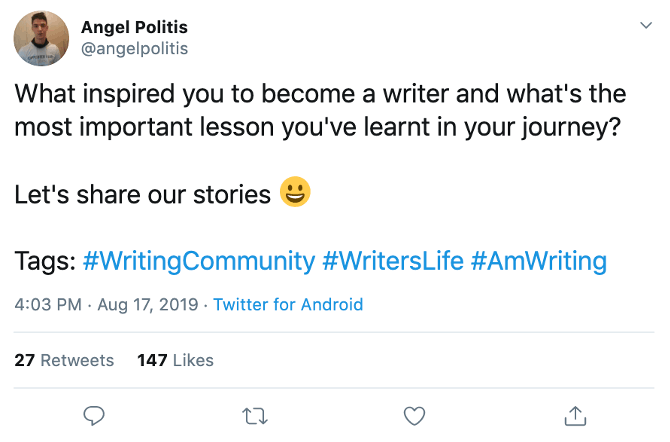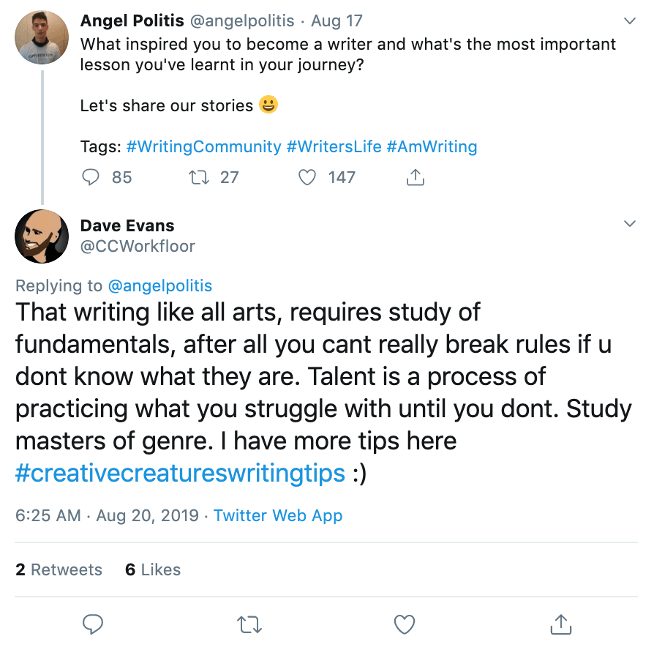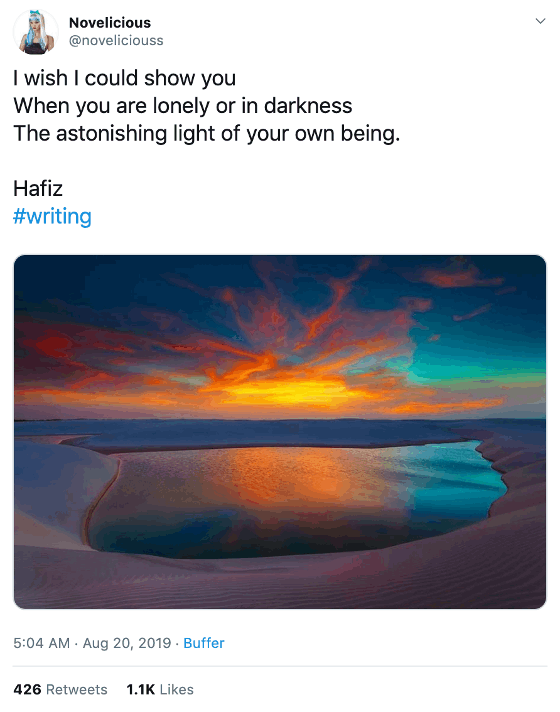
Following ethical considerations, one of the greatest challenges of the project was determining which terms to include, particularly when trying to understand the contours of the writing community on Twitter. I addressed this issue by grouping terms into two different categories: those related explicitly to the writing community and those that indicate the literariness of a given tweet. I scraped for multiple terms related to each category, but given the open-endedness of Twitter and the user’s ability to turn any word or phrase into a hashtag, the sheer number of search terms is overwhelming, and it was impossible to scrape for all terms. I therefore spent time on Twitter familiarizing myself with the hashtags used by the writing community.
Given the volatile and decentralized nature of Twitter, I noticed that many writers use multiple hashtags related to writing or the writing community to tag their tweets. I used such networks and overlaps as a means of determining the most commonly used hashtags for Twitter writers. For the writing community on Twitter, I accordingly decided to limit my efforts to the ten following hashtags: #fictioncommunity, #poetrycommunity, #poetsociety, #writercommunity, #writerscommunity, #writingcommunity, #writernetwork, #writerslife, #writingsociety, and #writersoftwitter. For the literary tweets on Twitter (i.e., the tweets that are explicitly tagged as a poem or short story in some form), I used twenty-five hashtags, namely: #3lines, #5lines, #flashfiction, #gogyoshi, #haiku, #microfiction, #micropoem, #micropoetry, #microtales, #nanotales, #poetryontwitter, #poetweet, #shortstories, #shortstory, #tanka, #twifi, #twitfic, #twitfiction, #twitlit, #twitterature, #twitterfiction, #twitterpoem, #twitterstory, #veryshortstory, and #vss.
It’s worth pausing to discuss the rationale behind these lists, including some noticeable omissions. First, I wanted to identify the active writing community on Twitter, which includes amateur writers just launching their careers as well as posts by writers about common concerns or issues that they might encounter. This kind of community involvement is demonstrated by the exchange between Angel Politis and Dave Evans (see Images 3 and 4). Using the hashtags #WritingCommunity, #WritersLife, and #AmWriting, Politis tweeted: “What inspired you to become a writer and what’s the most important lesson you’ve learnt in your journey? Let’s share our stories.” To which Evans responded: “That writing like all arts, requires study of fundamentals… Study masters of genre.” Evans also included the hashtag #creativecreatureswritingtips, thereby linking Politis’s question to a hashtag channel explicitly devoted to sharing writing tips. It is this kind of active community engagement that I hoped to capture with the selection of writing-community hashtags I used in my analysis. I did not, however, include #writing in my analysis of this community, since posts using this hashtag generally dealt less with issues or struggles by current writers; rather, most posts using #writing include images with inspirational quotes from professional writers, similar to the post by Novelicious on Aug. 20, 2019 (see Image 5).

Image 3: Tweet by Angel Politis.

Image 4: Tweet by Dave Evans in response to Angel Politis.

Image 5: Tweet by Novelicious quoting the
14th century Persian poet Hafiz.
Considerations for determining which hashtags to include in the fiction and poetry hashtag list were more complicated. First, the aim was to identify tweets that actually contained fiction or poetry being published on Twitter. As mentioned above, #writing often contained inspirational quotes rather than original works by amateur Twitter writers, and thus using this hashtag to measure literary output on Twitter would have vastly skewed the results. A better approach, then, was to use hashtags related to a specific literary form or genre, such as #shortstory or #haiku. But this, of course, raises the question: Why use these particular hashtags and not more typical literary genres, such as #epic or #lyric? There are two answers to this question. First, Twitter naturally lends itself to shorter forms of writing, given its limit of 240 characters (since Nov. 2017; from 2006 through Oct. 2017, Twitter only allowed 140 characters per tweet). Such limitations naturally make #flashfiction or #nanotales a better choice for writers seeking to express the brevity of their work. Second, many of the traditional literary genres have been appropriated for other cultural references on Twitter. #epic, for instance, is used to denote a particularly stunning or outrageous event, and #lyric is used to tag songs or pop music; these two hashtags are rarely (if ever) used as literary references on Twitter. The twenty-five literary hashtags that I identified and used in my analysis balance considerations of form and genre, and before deciding on these terms, I sampled search results on Twitter to verify that each of these hashtags is primarily used to tag poetic or fictional output.
It should be noted that there are other - equally important - writing communities and genres developing on Twitter, and hashtags that I didn’t scrape for include #queerfiction, #gaystories, #blackfiction, and #blackscifi, among others. While the communities surrounding these hashtags are certainly worthy of study, I found that most posts with these more specific hashtags were also tagged with #shortstory, #vss (which stands for “very short story”), or another more generic writing-related hashtag. I therefore decided to scrape Twitter only for the more generic hashtags, though I certainly hope to analyze these more specific writing communities in future.